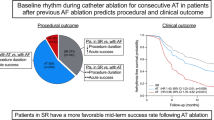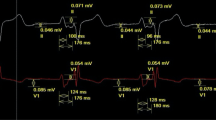Abstract
Background
A short baseline atrial fibrillation (AF) cycle length (CL) has been associated with a worse outcome after catheter ablation for AF, whereas the impact of a long baseline AFCL is unknown. We investigated the influence of AFCL on acute and long-term success in a large series of patients undergoing catheter ablation for persistent AF.
Methods
Overall, 177 consecutive patients undergoing catheter ablation of persistent AF using a sequential ablation approach were included in the analysis. AFCL was measured in the left atrial appendage (LAA) at baseline and following each ablation step. The primary endpoint was freedom from any atrial arrhythmia off antiarrhythmic drugs (AAD) with a single ablation procedure after 12 months.
Results
Mean AFCL was 164 ± 24 ms. A shorter AFCL was associated with longer AF duration, larger LA diameter, and longer procedure duration.
Termination to sinus rhythm (SR) was achieved in 57 (32 %) patients. Baseline AFCL was shorter (161 ± 24 ms) in patients without AF termination compared to patients with AF termination (169 ± 23 m, p = 0.03).
The primary endpoint was reached less frequently in patients with a short (<155 ms) AFCL (18 vs. 38.5 %, p = 0.006). Patients with an AFCL between 155 and 200 ms had the best outcome compared to patients with AFCL <155 or ≥200 ms (40 vs. 18 %, p = 0.003).
Conclusions
Patients with a baseline AFCL between 155 and 200 ms have the best outcome after a single ablation procedure for persistent AF compared to patients with an AFCL of <155 or ≥200 ms.



Similar content being viewed by others
References
O’Neill, M. D., Wright, M., Knecht, S., Jaïs, P., Hocini, M., Takahashi, Y., et al. (2009). Long-term follow-up of persistent atrial fibrillation ablation using termination as a procedural endpoint. European Heart Journal, 30, 1105–1112.
Knecht, S., Hocini, M., Wright, M., Lellouche, N., O’Neill, M. D., Matsuo, S., et al. (2008). Left atrial linear lesions are required for successful treatment of persistent atrial fibrillation. European Heart Journal, 29, 2359–2366.
Rostock, T., Steven, D., Hoffmann, B., Servatius, H., Drewitz, I., Sydow, K., et al. (2008). Chronic atrial fibrillation is a biatrial arrhythmia: data from catheter ablation of chronic atrial fibrillation aiming arrhythmia termination using a sequential ablation approach. Circulation. Arrhythmia and Electrophysiology, 1, 344–353.
Ammar, S., Hessling, G., Reents, T., Paulik, M., Fichtner, S., Schön, P., et al. (2013). Importance of sinus rhythm as endpoint of persistent atrial fibrillation ablation. Journal of Cardiovascular Electrophysiology, 24, 388–395.
D’Ascenzo, F., Corleto, A., Biondi-Zoccai, G., Anselmino, M., Ferraris, F., di Biase, L., Natale, A., Hunter, R. J., Schilling, R. J., Miyazaki, S., Tada, H., Aonuma, K., Yenn-Jiang, L., Tao, H., Ma, C., Packer, D., Hammill, S., Gaita, F. (2012). Which are the most reliable predictors of recurrence of atrial fibrillation after transcatheter ablation? A meta-analysis. International Journal of Cardiology, 167(5):1984–1989.
Mohanty, S., Mohanty, P., Di Biase, L., Bai, R., Pump, A., Santangeli, P., et al. (2012). Impact of metabolic syndrome on procedural outcomes in patients with atrial fibrillation undergoing catheter ablation. Journal of the American College of Cardiology, 59(14), 1295–1301.
Den Uijl, D. W., Tops, L. F., Delgado, V., Schuijf, J. D., Kroft, L. J., de Roos, A., et al. (2011). Effect of pulmonary vein anatomy and left atrial dimensions on outcome of circumferential radiofrequency catheter ablation for atrial fibrillation. American Journal of Cardiology, 107, 243–249.
McCready, J. W., Smedley, T., Lambiase, P. D., Ahsan, S. Y., Segal, O. R., Rowland, E., et al. (2011). Predictors of recurrence following radiofrequency ablation for persistent atrial fibrillation. Europace, 13, 355–361.
Nattel, S., Burstein, B., & Dobrev, D. (2008). Atrial Remodeling and Atrial Fibrillation: Mechanisms and Implications. Circulation. Arrhythmia and Electrophysiology, 1, 62–73.
Kim, K.-B., Rodefeld, M. D., Schuessler, R. B., Cox, J. L., & Boineau, J. P. (1996). Relationship between local atrial fibrillation interval and refractory period in the isolated canine atrium. Circulation, 94, 2961–2967.
Haissaguerre, M., Sanders, P., Hocini, M., Hsu, L.-F., Shah, D., Scavee, C., et al. (2004). Changes in atrial fibrillation cycle length and inducibility during catheter ablation and their relation to outcome. Circulation, 109, 3007–3013.
Estner, H. L., Hessling, G., Ndrepepa, G., Luik, A., Schmitt, C., Konietzko, A., et al. (2008). Acute effects and long-term outcome of pulmonary vein isolation in combination with electrogram-guided substrate ablation for persistent atrial fibrillation. American Journal of Cardiology, 101, 332–337.
Nademanee, K., Lockwood, E., Oketani, N., & Gidney, B. (2010). Catheter ablation of atrial fibrillation guided by complex fractionated atrial electrogram mapping of atrial fibrillation substrate. Journal of Cardiology, 55, 1–12.
Gaspo, R., Bosch, R. F., Talajic, M., & Nattel, S. (1997). Functional mechanisms underlying tachycardia-induced sustained atrial fibrillation in a chronic dog model. Circulation, 96, 4027–4035.
Wijffels, M., Kirchhof, C., Dorland, R., & Allessie, M. (1995). Atrial fibrillation begets atrial fibrillation. A study in awake chronically instrumented goats. Circulation, 92, 1954–1968.
Verheule, S., Tuyls, E., van Hunnik, A., Kuiper, M., Schotten, U., & Allessie, M. (2010). Fibrillatory conduction in the atrial free walls of goats in persistent and permanent atrial fibrillation. Circulation. Arrhythmia and Electrophysiology, 3, 590–599.
Haissaguerre, M., Lim, K. T., Jacquemet, V., Rotter, M., Dang, L., Hocini, M., et al. (2007). Atrial fibrillatory cycle length: computer simulation and potential clinical importance. Europace, 9, 64–70.
Yokokawa, M., Latchamsetty, R., Good, E., Crawford, T., Jongnarangsin, K., Pelosi, F., Jr., et al. (2012). The impact of age on the atrial substrate: insights from patients with a low scar burden undergoing catheter ablation of persistent atrial fibrillation. Journal of Interventional Cardiac Electrophysiology, 34, 287–294.
Wang, Z., Page, P., & Nattel, S. (1992). Mechanism of flecainide’s antiarrhythmic action in experimental atrial fibrillation. Circulation Research, 7, 271–287.
O’Neill, M. D., Jaïs, P., Takahashi, Y., Jönsson, A., Sacher, F., Hocini, M., et al. (2006). The stepwise ablation approach for chronic atrial fibrillation—evidence for a cumulative effect. Journal of Interventional Cardiac Electrophysiology, 16(3), 153–167.
Haïssaguerre, M., Sanders, P., Hocini, M., Takahashi, Y., Rotter, M., Sacher, F., et al. (2005). Catheter ablation of long-lasting persistent atrial fibrillation: critical structures for termination. Journal of Cardiovascular Electrophysiology, 16, 1125–1137.
Matsuo, S., Lellouche, N., Wright, M., Bevilacqua, M., Knecht, S., Nault, I., et al. (2009). Clinical predictors of termination and clinical outcome of catheter ablation for persistent atrial fibrillation. Journal of the American College of Cardiology, 54(9), 788–795.
Drewitz, I., Willems, S., Salukhe, T. V., Steven, D., Hoffmann, B. A., Servatius, H., et al. (2010). Atrial fibrillation cycle length is a sole independent predictor of a substrate for consecutive arrhythmias in patients with persistent atrial fibrillation. Circulation. Arrhythmia and Electrophysiology, 3, 351–360.
Arbelo, E., Brugada, J., Hindricks, G., Maggioni, A. P., Tavazzi, L., Vardas, P., Laroche, C., Anselme, F., Inama, G., Jais, P., Kalarus, Z., Kautzner, J., Lewalter, T., Mairesse, G. H., Perez-Villacastin, J., Riahi, S., Taborsky, M., Theodorakis, G., Trines, S. A. (2014). On the behalf of the Atrial Fibrillation Ablation Pilot Study Investigators. The Atrial Fibrillation Ablation Pilot Study: an European survey on methodology and results of catheter ablation for atrial fibrillation: conducted by the European Heart Rhythm Association. European Heart Journal. doi:10.1093/eurheartj/ehu001.
Rostock, T., Salukhe, T. V., Steven, D., Drewitz, I., Hoffmann, B. A., Bock, K., et al. (2011). Long-term single and multiple procedure outcome and predictors of success after catheter ablation for persistent atrial fibrillation. Heart Rhythm, 8(9), 1391–1397.
Mahnkopf, C., Badger, T. J., Burgon, N. S., Daccarett, M., Haslam, T. S., Badger, C. T., et al. (2010). Evaluation of the left atrial substrate in patients with lone atrial fibrillation using delayed-enhanced MRI: implications for disease progression and response to catheter ablation. Heart Rhythm, 7, 1475–1481.
Conflict of interest
None declared.
Author information
Authors and Affiliations
Corresponding author
Electronic supplementary material
Below is the link to the electronic supplementary material.
Figure A
(supplemental material): The plot shows the distribution of baseline atrial fibrillation cycle lengths in patients with and without an observed arrhythmia during follow-up. The horizontal line indicates the cutoff value of 155 ms (PPTX 253 kb)
Rights and permissions
About this article
Cite this article
Ammar, S., Hessling, G., Paulik, M. et al. Impact of baseline atrial fibrillation cycle length on acute and long-term outcome of persistent atrial fibrillation ablation. J Interv Card Electrophysiol 41, 253–259 (2014). https://doi.org/10.1007/s10840-014-9927-6
Received:
Accepted:
Published:
Issue Date:
DOI: https://doi.org/10.1007/s10840-014-9927-6




